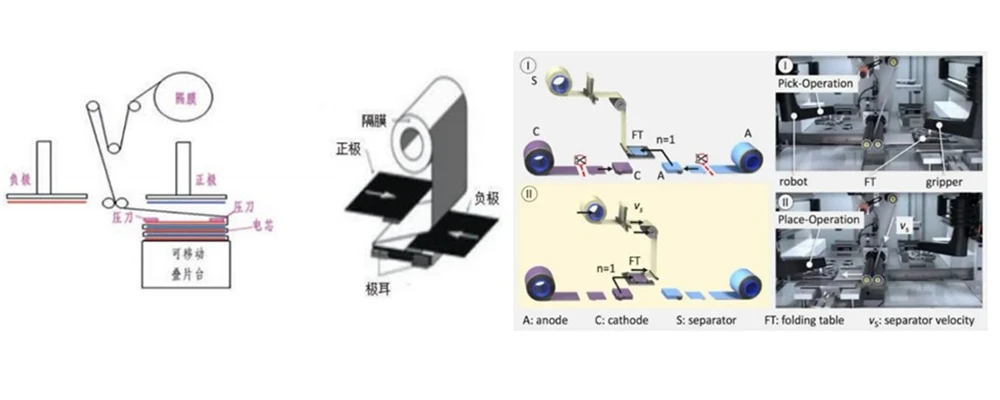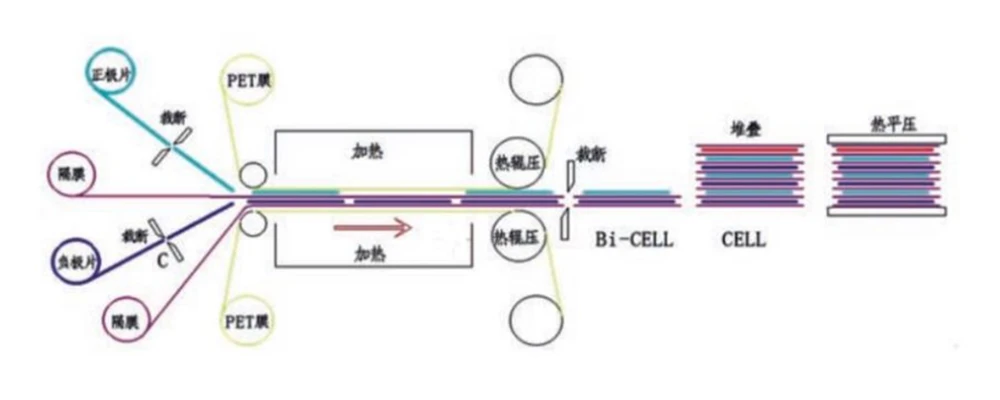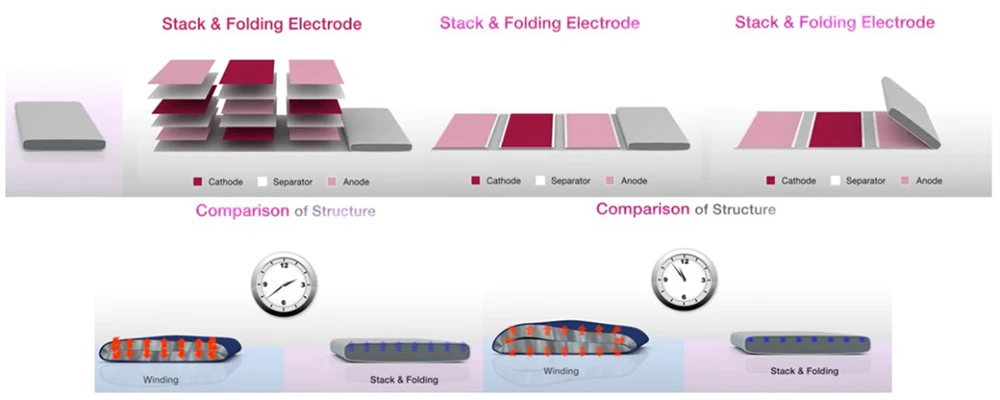Lithium-ion battery stacking technology is
a critical process in cell manufacturing, directly impacting performance,
safety, and production efficiency. At TOB NEW ENERGY, we specialize
in providing turnkey battery production line solutions and
cutting-edge equipment tailored to optimize these advanced processes.
Currently, four primary stacking technology routes dominate the industry:
Z-Folding, Cut & Stack Integration, Thermal Lamination Stacking, and Stack
& Folding (LG's proprietary method). While Z-Folding and Cut & Stack
Integration (essentially an enhanced Z-type) are widely adopted in China,
Thermal Lamination offers superior speed and quality with higher complexity.
Internationally, LG Energy Solution utilizes the highly efficient,
patent-protected Stack & Folding method.
Table: Comparison of Main Stacking
Technologies (Stack & Folding is LG Patent)
|
Feature
|
Z-Folding
|
Cut & Stack Integration
|
Thermal Lamination Stacking
|
Stack & Folding
|
|
Principle
|
Movable table folds separator in Z-shape,
placing pre-cut electrodes
|
Integrates die-cutting/laser cutting,
Z-folding, & tab welding/pressing
|
Pre-cut electrodes & separator are
heat-laminated, then stacked
|
Electrodes attached to separator,
rolled/folded to interleave +/-
|
|
Efficiency
|
0.45-0.6 s/piece/station
|
0.45-0.8 s/piece/station
|
~0.125 s/piece
|
--
|
|
Burr
|
≤10μm
|
≤15μm
|
≤10μm
|
--
|
|
Alignment
|
±0.4mm
|
±0.4mm
|
±0.0.6mm
|
±0.4mm
|
|
Uptime
|
95%
|
95%
|
95%
|
--
|
|
Key Traits
|
Risk of misfeeds, separator tension
issues, wrinkling
|
Solves Z-folding issues, boosts
efficiency & yield
|
High speed/efficiency, involves patents
|
High efficiency (LG patent protected)
|
Detailed Analysis of Lithium-ion Battery
Stacking Technologies
Z-Folding Technology
-
The most common method involves a movable table pulling the separator
back-and-forth (Z-shape) between platforms, alternately stacking anode and
cathode sheets. While established, it faces inherent challenges:
-
Separator Deformation: The oscillating
motion creates asymmetric tension, leading to inconsistent stretching,
deformation, and changes in porosity, pore size, and surface area –
ultimately compromising cell quality. Explore our customized
battery equipment solutions designed to mitigate such process
challenges.
-
Limited Efficiency: The need
to swing the separator for each electrode placement restricts speed.
Typical rates are 0.5s/piece/station. For a 30-layer cell, this means 15
seconds per cell, or just 4 cells per minute (4 PPM). This bottleneck
hinders high-volume production.

Cut & Stack Integration Technology
-
An evolution of Z-folding, this integrates die-cutting/laser cutting,
Z-folding, and tab welding/pressing into a single machine, becoming a key
industry trend due to improved yield and speed.
-
Enhanced Yield: Combining
processes minimizes electrode handling and transfer between stations,
significantly reducing risks like damage, burrs, tab bending, and
misfeeds during pick-and-place from cassettes. Discover our integrated
battery pilot line solutions that leverage this efficient
technology.
-
Increased Speed: Electrodes
and separator are fed and folded simultaneously. After reaching the set
count, the separator is cut, tabs welded, and the stack pressed. Leaders
like Hangke (Hefei) achieve up to 800 PPM (0.075s/piece), while Hymson
reports 0.15s/piece (3-station).
Thermal Lamination Stacking Technology
-
This advanced process feeds cathode roll, anode roll, and adhesive-coated
separator simultaneously. Electrodes are cut in-line. The
combined strip enters a heating system, undergoes thermal lamination and
calendering, is cut into individual units ("Bi-cells"), and
stacked mechanically. The stack is finally hot-pressed.
-
Key Advantages: Continuous,
unidirectional feeding ensures stable tension and speed, eliminating
separator deformation issues seen in Z-folding. This results in superior
stack flatness, consistent separator properties (mechanical strength,
porosity), and optimal electrode-separator interfaces, leading to higher
quality cells, especially for large-format, high-energy-density
applications. While technically complex (involving lamination, precise
cutting, and posing challenges for later electrolyte filling), its integrated
approach (combining forming, stacking, pressing) is space-efficient and
highly productive. For cutting-edge applications like solid-state
batteries or dry electrode technology, robust
stacking solutions are crucial.

Stack & Folding Technology (LG Patent)
-
Developed by LG Energy Solution (equipment by MANZ), this proprietary
method involves cutting electrodes, placing them onto a separator via
rotating tables/vacuum chucks, then folding/rolling the assembly to
interleave the electrodes. LG utilizes its proprietary SRS (Safety
Reinforced Separator) – a ceramic-coated, heat-treated separator enhancing
mechanical strength and safety by preventing internal shorts. While highly
efficient, this technology is protected by LG patents and not commercially
available to other manufacturers. Need advanced battery materials like
specialized separators? TOB NEW ENERGY provides comprehensive battery material
support.

Future Trends in Lithium-ion Battery
Stacking Technology
Stacking technology continues to evolve rapidly:
-
Rise of Cut & Stack Integration: As the dominant domestic Z-folding method faces yield and
speed limitations, Cut & Stack Integration is becoming the preferred
choice in China. Its integrated design significantly boosts yield and
efficiency.
-
Relentless Focus on Speed: Overcoming
the historical efficiency gap compared to winding is paramount. Major
Chinese equipment manufacturers are intensely focused on increasing
stacking speeds (PPM) to make stacking competitive for mass production
across more applications. Achieving this is key to wider adoption versus
winding.
Optimize Your Stacking Process with TOB
NEW ENERGY
Understanding the nuances of stacking technologies is vital for selecting the
right process for your battery's performance, safety, and production
goals. TOB NEW ENERGY offers unparalleled expertise and
solutions:
-
Tailored Stacking Equipment: We
provide customized Battery stacking machines (Z-type, Cut &
Stack, Thermal Lamination) designed for your specific R&D, pilot, or
mass production needs.
-
End-to-End Production Lines: From
lab-scale to GWh-scale factories, we deliver complete, turnkey
battery production lines incorporating the optimal stacking
technology for your application.
-
Advanced Material Supply: Source
high-performance separator films, electrode materials, and adhesives
critical for advanced stacking processes through our comprehensive
battery materials portfolio.
-
Cutting-Edge Technical Support: Leverage
our deep expertise in next-generation battery technologies (solid-state,
sodium-ion, Li-S) to optimize your stacking process and overall cell
design.
Contact TOB NEW ENERGY today to discuss how
our integrated battery solutions can enhance your stacking
process efficiency, yield, and final cell quality.


